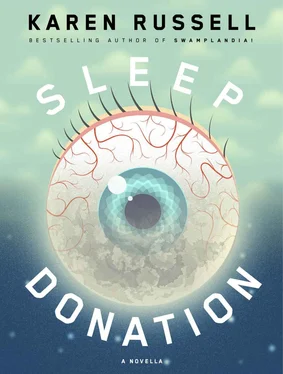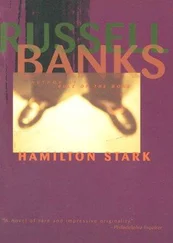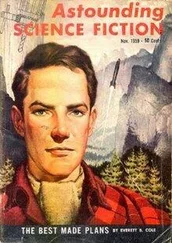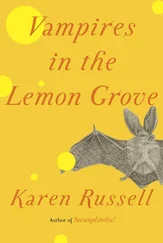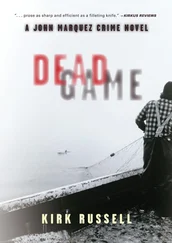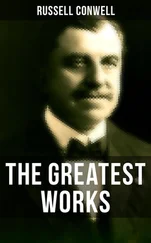Donor Y.
Why, why.
I become obsessed with him.
Was it a case of “malice aforethought”?
This term I learned from a high school book, Moby-Dick : a white whale ramming with blind hate into the hull of a boat, trying to kill everyone aboard.
“Malice aforethought,” the teacher explained, meant the whale could scheme, like a man, and design its revenge.
Perhaps Donor Y wanted to settle some score with the universe. Perhaps Donor Y was tired of being an anonymous sufferer in a crowd, and wanted to propagate his worst night. Gould’s machines gave him a way to tattoo his private horror onto the minds of strangers. This possibility —an uncomfortably arousing possibility —gets mentioned in every news story about the crisis. Villains sell papers. And I find that I prefer him this way: nasty, aware.
Donor Y, when I try to picture him, never develops a face. What I see instead is a husk, a humanoid virus, interested only in the dissemination and replication of its own pain.
You’ve heard about that sperm donor whose single cup of swimmers went on to sire legions of snub-nosed, blond half brothers and sisters? Our Donor Y has inseminated thousands of dreamers with his personal hell. He’s broadcast his nightmare to every demographic.
Donor Y, Baby A. I picture them as opposite poles on an axis. Donor Y, pumping out the nightmare, and Baby A, pumping out black sleep.
I find that I badly want Donor Y to be pure as well: purely evil.
And if he betrays me by showing up, becoming real? Just some middle-aged guy in a sweater, with one uncommonly virulent nightmare? This scenario, I hate: Donor Y gave no thought at all to the possibility that he might be such a carrier. He was a sincere do-gooder. He saw a flyer and wandered up to a registrant. An earnest brunette administrator ran down the questionnaire with him in the lunar-lit tent, and both of them believed that his responses were honest.
Last April, Rudy and Jim had me tell “Dori’s Story” at the Corps Sweet Dreams Benefit —our largest annual fund-raiser. At the ball, I stuttered, lost my place twice. I torpedo-sneezed into an audience of billionaires.
“No, Edgewater!” Rudy reassured me. “You got half the room with that. That snot was a good touch! I mean I know it wasn’t a ‘touch’ —with you, it’s never a performance —”
In the bathroom, I rinsed my eyes. A German woman approached me, a Deutsche Bank widow in shimmering green. She complimented me, in her way, on the purity of my grief: “Still so sad! After all these years and tellings!”
I’ve shared Dori with thousands of people now: reporters and talk show hosts; reluctant sleep donors; once, a jet-lagged, baffled, yet receptive African king at a strange and endless state lunch. Every single time I tell it, I go into convulsions. I show her photograph.
“She’s like a grief hemophiliac,” Rudy told the German widow, who was searching avidly for her checkbook; for an instant, we locked eyes over the sequined shoulder pad of this woman’s evening gown. “It doesn’t clot. It never runs dry.”
Is our appeal to this alpha breed of ego a bad thing? Rudy argues that it’s one of our greatest accomplishments —that the Corps reorients the flow of ego, like the old river-dammers who got the water to run backwards and irrigate a dry world. We at the Slumber Corps are hydraulic engineers. We redistribute funds, dreams, to eradicate thirst. And I don’t disagree; only it’s a strange way to help the living, to continually dredge her up, my sister.
I’ve been giving a lot of thought to the similarities between what I do and what’s been done by Donor Y. Thanks to my efforts, millions of people are infected with Dori’s last breath. My job, as I understand it, is to compel our donors to feel the horror of her death. To “spread awareness.”
“It won’t bring her back,” a trustee once told me soapily over another endless Slumber Corps charity spaghetti dinner, as if lathering his own hands with this antiseptic wisdom. Which, oh God, caused me to swallow a small withered tomato whole so I could hiss across the table, “I know that!”
At the same time, what am I doing, if not reseeding my dead sister into as many fertile minds and bodies as possible?
Sometimes I think the right doctor could open my chest and find her there, my sister, frozen inside of me, like a face in a locket.
Donor Y and The Elective Insomniacs
Ten days after Donor Y’s story breaks, the San Francisco ER admits a group of twenty chattering maniacs who are refusing sleep. Every one of them tests positive for the Donor Y nightmare. These people were not our patients. They did not receive transfusions from American sleep banks. They were passengers on Flight 109, from Havana to SFO. Immediately, the passengers become misery-celebrities. They represent an entirely new species of revenant in our midnight world.
We learn that these people were part of a group of sixty-one medical tourists. As recently as a week ago, not one of these twenty new victims of the nightmare contagion could fall asleep. Either unwilling or unable to wait another night on the Slumber Corps rolls, they’d chartered a flight to Cuba and paid to receive an experimental sleep transfusion. They spent a week recovering in Havana, cocooned in a secret room behind the Malecón Hospital, near the leafy gold light and the shining Bahia. Sleeping and dreaming, assimilating the transfusion. During that time, the Cuban doctors confirmed that twenty of the twenty-two American recipients had regained their ability to fall asleep on their own. As happens in the best-case scenarios, a single transfusion had jolted them into their original sleep-wake cycles. The return flight to San Francisco should have been a beautiful milestone for these people: stars shuttling past the cabin windows, the recovered insomniacs drifting into natural sleep. Half an hour into the flight, the steward reported hearing piercing screams throughout the cabin. A fifty-three-year-old male passenger from North Carolina, snoring in a middle seat, 13B, was the first to present symptoms of the Donor Y nightmare. Soon half a dozen other passengers seemed to be plummeting into the same dream, and then the howls came at regular intervals, according to the steward at the press conference, “everyone screaming at once, the way a Ferris wheel sounds, like they were all going in circles.”
The Corps was not unaware that such medical tourism occurred. They had reports of sleep transfusions being offered for cash already under way in Cuba, Vietnam, Haiti, western Germany, despite Headquarters’ issued warnings to American insomniacs regarding these “back-alley dream dealers,” decrying their lack of oversight and regulation, their profit-hunger, their shabby facsimiles of Gould’s machines. What nobody knows is how the Cubans wound up with units of the tainted sleep in the first place.
Fusillades of educated speculation erupt on our TVs:
Units of the infected sleep have crossed the ocean, through some black-market transaction.
An American who received one of the tainted sleep transfusions gave —or sold —her infected sleep abroad.
And then things shade into hysteria, with some people alleging that the Donor Y pathogen has gone airborne. What if it was sneezed out, coughed up, a scum of germs on skin? What if it was transmitted to all the passengers via the recycled air of the plane?
The Corps issues a press release: NIGHTMARE-PRIONS CAN ONLY BE TRANSMITTED THROUGH SLEEP TRANSFUSIONS. The Donor Y nightmare cannot be contracted orally, or through skin. It is not an airborne virus. It is not transmitted through insect bites, food, water, or sexual contact with a sick dreamer. There is no risk of transmission to a sleep donor.
Читать дальше
